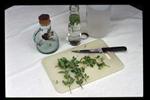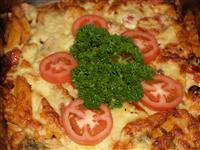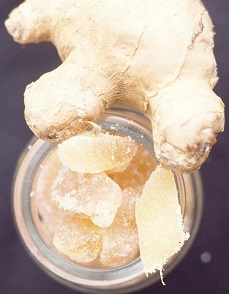Learn to Grow and Use Culinary Herbs
Get a job or start a business in herbs!

- Study for professional development or simply to indulge your passion
- Start a business -growing herbs or producing herb products
- Self paced course; study from anywhere, start any time.
‘Herbs’ include a large group of aromatic plants that includes soft stemmed herbaceous plants, annuals, bulbs, woody plants and even larger shrubs and trees, that are useful to human beings, and used for a variety of reasons. Many, but not all are edible.
 The fresh and dried leaves, flowers and sometimes stems of culinary herbs are the ones used in cooking. They include sage, tarragon, chives, parsley and a multitude of other species. Sometimes people confuse culinary herbs with spices. Spices are usually powdered substances produced from the grinding of seeds, roots, bark, fruit and sometimes the flowers or flower parts i.e. cardamom (seeds), cinnamon (bark), saffron (actually the stamens of the flowers).
The fresh and dried leaves, flowers and sometimes stems of culinary herbs are the ones used in cooking. They include sage, tarragon, chives, parsley and a multitude of other species. Sometimes people confuse culinary herbs with spices. Spices are usually powdered substances produced from the grinding of seeds, roots, bark, fruit and sometimes the flowers or flower parts i.e. cardamom (seeds), cinnamon (bark), saffron (actually the stamens of the flowers).
COURSE STRUCTURE AND LESSON CONTENT
There are 8 lessons in this course, as outlined below:
Lesson 1. Introduction
- Scope and Nature of Culinary Herbs
- Herbs and Horticulture
- Accurately Identifying Herbs
- Plant Classification, binomial system
- Finding the group a herb fits into -Monocotyledons and Dicotyledons, Plant
- Families
- Pronouncing Plant Name
- Resources - information contacts (i.e. nurseries, seed, clubs etc.)
Lesson 2. Culture
- Overview
- Soils
- pH Requirements
- Improving soil
- Potting mixes
- Plant Nutrition and Fertilizers
- Water Management for Herbs
- Diagnosing Plant Health Problems
- Pests, Disease and Environmental Problems
- Planting, staking, and establishing herb plants, etc.
Lesson 3. Growing Herbs
- Propagation of herbs
- Seed Propagation
- Cutting Propagation
- Potting Media
- Division, Separation, Layering
- Rejuvenation of Perennials
- Designing a Culinary Herb Garden
- Creating a Kitchen Garden
- Planning a Fragrant Herb Garden
- Companion Planting in Your Design
Lesson 4. Cooking With Herbs
- General Guidelines for Using Herbs in Cooking
- Harvesting Herbs; roots, leaves, seed, fruits
- Handling after Harvest
- Drying Herbs
- Hints for Using a Range of Selected Herbs in Cooking
- Herbs For Garnish
- Herbal Teas: What & how to use different herbs
- Herb Vinegars, oils, butters, cheeses, salts, sugars, honey,, etc
- Herb Confectionary, Cakes, etc.
- Selected Herb Recipes
- Using Herbs with Fruit
Lesson 5. Most Commonly Grown Varieties
- Review of many Common Culinary herbs, including their culture and culinary use
- Over 20 herbs reviewed in detail, incl. Alliums
- Many additional herbs summarized
Lesson 6. Other Important Groups
- Lamiaceae (mint family) herbs
- Lemon Scented Herbs and their uses
- Hyssop
- Mints
- Bergamot
- The Basils
- Origanum species
- Rosemary
- Salvias
- Thymes
- Lavenders
Lesson 7. The Lesser Grown Varieties
- Agastache
- Agrimony
- Visnaga
- Apium
- Arctium lappa
- Bundium
- Capparis; and many more
- Using Australian Native Plants as Flavourings
Lesson 8. Special Assignment
- A PBL Project on a selected genus of culinary herbs
COURSE AIMS
- Describe the plant naming system, the major family groups that herbs fall into and the resources available to the culinary herb grower.
- Describe how to manage the cultural requirements of culinary herbs.
- Describe the various methods of propagation, both sexual and asexual, the treatments generally used for seed storage and the handling of cutting material.
- Explain the way in which herbs are used in cooking and which herbs best suit various dishes.
- Discuss the most common herb varieties used in cooking.
- Compare a range of culinary herbs in a single plant family.
- Discuss a range of lesser grown culinary herb varieties.
- Explain the uses of a range of culinary herbs within a specific group of herb plants.
HOW TO USE HERBS IN COOKING
Herbs can greatly enhance the flavour of a dish if used correctly, but, conversely can just as easily ruin it.
- Too much of a herb can make the flavour overpowering and completely overshadow the natural flavour of the food it is added to.
- Too little of a herb in a food will achieve nothing.
- The addition of herbs must be balanced to complement the flavours which are already in a food.
- It is important to blend different herbs in appropriate ratios to achieve the best results.
The amount of flavour imparted to food by a herb depends on many things, including:
- Stage of growth at which the herb was harvested.
- Part of the plant which is used.
- Time of year the herb is harvested.
- Length of time the herb is left to stand in liquid or solid mixtures before it is used
- Temperature which the mixture is at while the herb is standing in it.
- The temperature the dish is cooked at.
- The length of time the dish is cooked.
- Moisture content of the dish which is being cooked (e.g. a stew will absorb flavours differently to a piece of barbecued meat).
It often requires a fair amount of experimentation for you to achieve just the right flavour combination that best suits your personal preferences. The best way is to only use small amounts of each herb to start off with, and allowing sufficient time for the herbs to impart their flavours to the food. Then taste the food, and if the flavour you desire is not strong enough add a little more of the herb and repeat the process. As you become more familiar, over time, with using particular herbs in different types of foods you should get a feel for how much of each herb to add.
Something to Try:
Grilled Red Capsicum Salad with Basil
Red Capsicums are lovely in this dish but a mix of yellow, green and red looks great on the plate.
Remove the skins from 500 grams of capsicums by blistering the skins under a grill (cut them in half and remove the seeds first – them squash the halves flat. Once the skin is black place the peppers in a brown paper bag – this helps loosen the skin. Remove the blackened skin once the peppers are cool and cut into strips. Arrange the peppers on an attractive serving dish.
Other Ingredients
2-3 tablespoons basil flavoured oil
2 tablespoons of roasted pine nuts
1 – 2 tablespoons of lemon juice
2 Teaspoons of fresh chopped basil
Salt to taste
Heat the oil in a small fry pan and add the pine nuts – cook gently until golden; add the lemon juice and pour over the salad. Garnish with the chopped basil and season with a pinch of salt.
Spice or Herb - What's the Difference?
 Spices might in many ways, be considered just a type of herb.
Spices might in many ways, be considered just a type of herb.
Spices come from the aromatic parts of plants which are dried. This includes seeds, bark, roots, leaves, fruit – in fact, all plant parts may have some use, depending on the particular plant.
Spices are usually processed into a powder that can then be stored and readily used in cooking. Some spices (e.g. cinnamon, peppers and cloves) are only grown in the tropics, but others can be grown elsewhere. After grinding, it important to store and use powdered herbal spices in an appropriate way.
How to Store Spices
- Spices which are sealed in airtight containers straight after processing will last up to three years if unopened.
Flavour and aroma is retained longer in airtight containers and if stored in cooler places like a cupboard. In hot climates you might need to keep spices in the fridge.
- Once a container is opened, whole spices (dried seeds and plant parts) will last for around two years. Ground spices begin to deteriorate after 6-12 months.
- Don’t place your spice rack too near to heat sources like the stove top. Heat will cause spices to lose flavour and steam will cause them to become tacky.
- Some spices will also lose colour if placed in bright light. Significant colour loss is also often accompanied by flavour loss. Once again, a cool, dark place is favourable.
- Excess spices may be frozen in sealed bags or containers to preserve them for later use. Frozen spices will not deteriorate.
Using and Assessing Spices
- Always use a clean, dry spoon to remove spices from containers. Moisture will cause spices to become tacky. Soiled spoons will ruin flavour.
-
- Dried spices are more intense than fresh ones, so use about a third as much in cooking.
- Check your spices annually for freshness. Remove the container lid and smell them. You should be able to detect their aroma without having to stick your nose into the container.
- To test whole seeds, pods, or other plant parts for freshness, grind some using a mortar and pestle and give them the smell test.
- If you are unsure about how to detect fresh smells try comparing some old out-of-date spices with freshly ground ones.
WHAT OUR STUDENTS SAY
"I have found the course interesting and it has expanded my knowledge of herbs immensely."
D. Christian
" I wanted to study herbs .... ACS offered the best option - study at home, at my own pace and still tutor contact when I needed it. I was undecided in the facet of herbs that I wanted to specialise in - that was until I completed an assignment to produce three herbal products. My tutor tested my products and encouraged me to set up a small business making and distributing a range of natural herbal cosmetic and household products. His guidance has helped me establish an interesting and profitable business from my studies"
Catherine, studying Certificate in Applied Management Herbs
WHO BENEFITS FROM DOING THIS COURSE?
This course will expand the culinary skills and knowledge of cooks, chefs and when cooking for the family.
A knowledge of culinary herbs is useful:
- In the home to create more interesting meals everyday
- For catering businesses to understand which herbs go with what
- For chefs and cooks to expand their menus
- For herb businesses such as small herb nurseries
- For those working on a herb farm or wanting to set one up.
Enrol and start exploring the wonders of culinary herbs today.
If you have any questions, or want to know more - get in touch with our highly experienced Horticulture tutors - they will be pleased to help you.